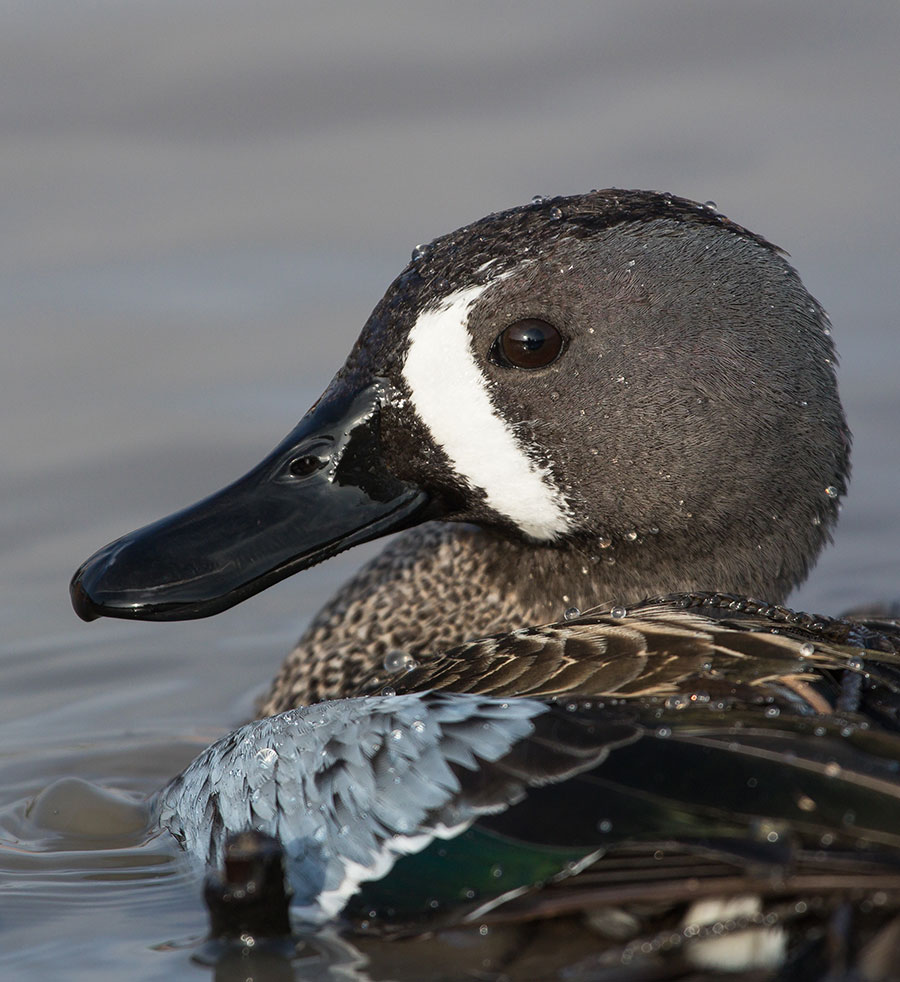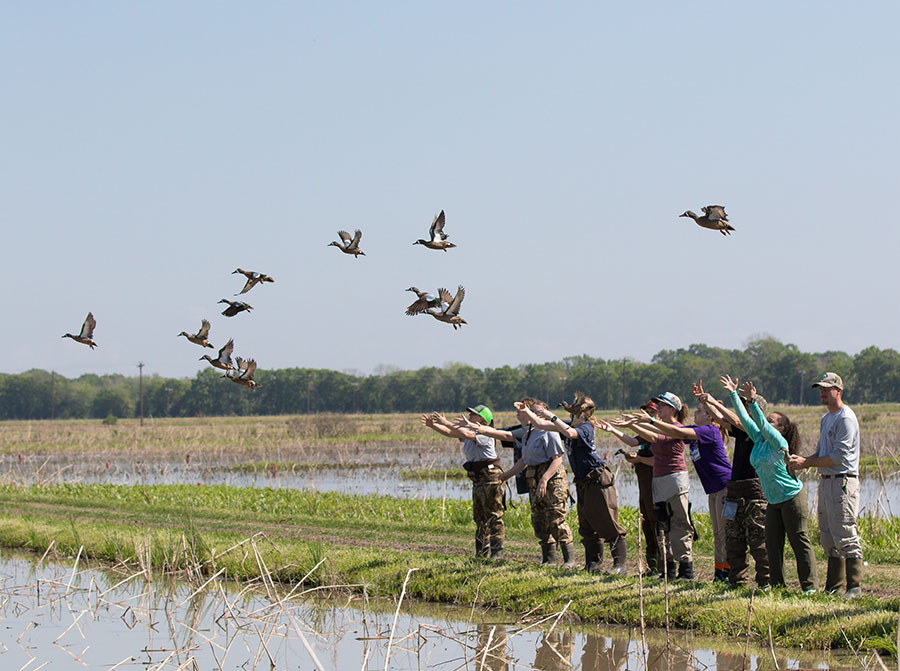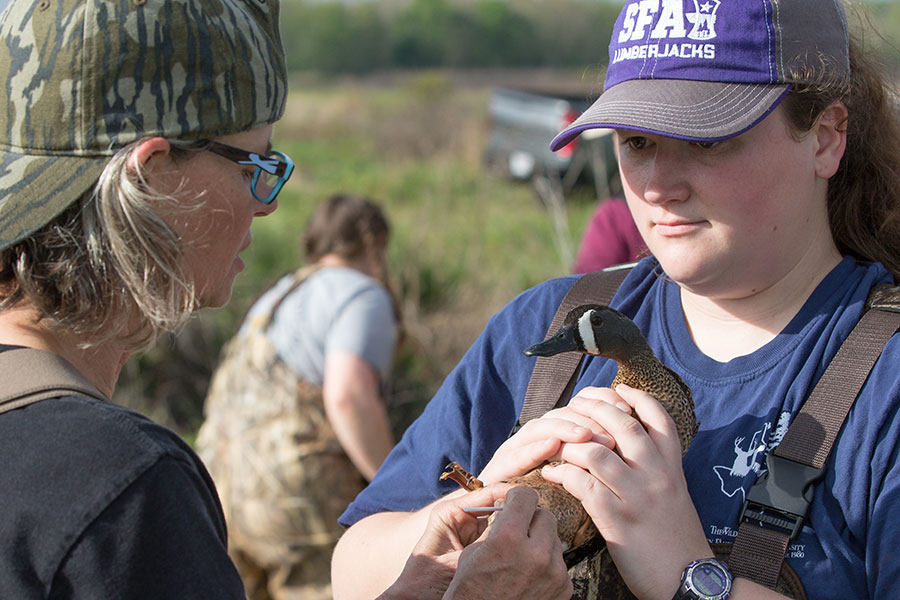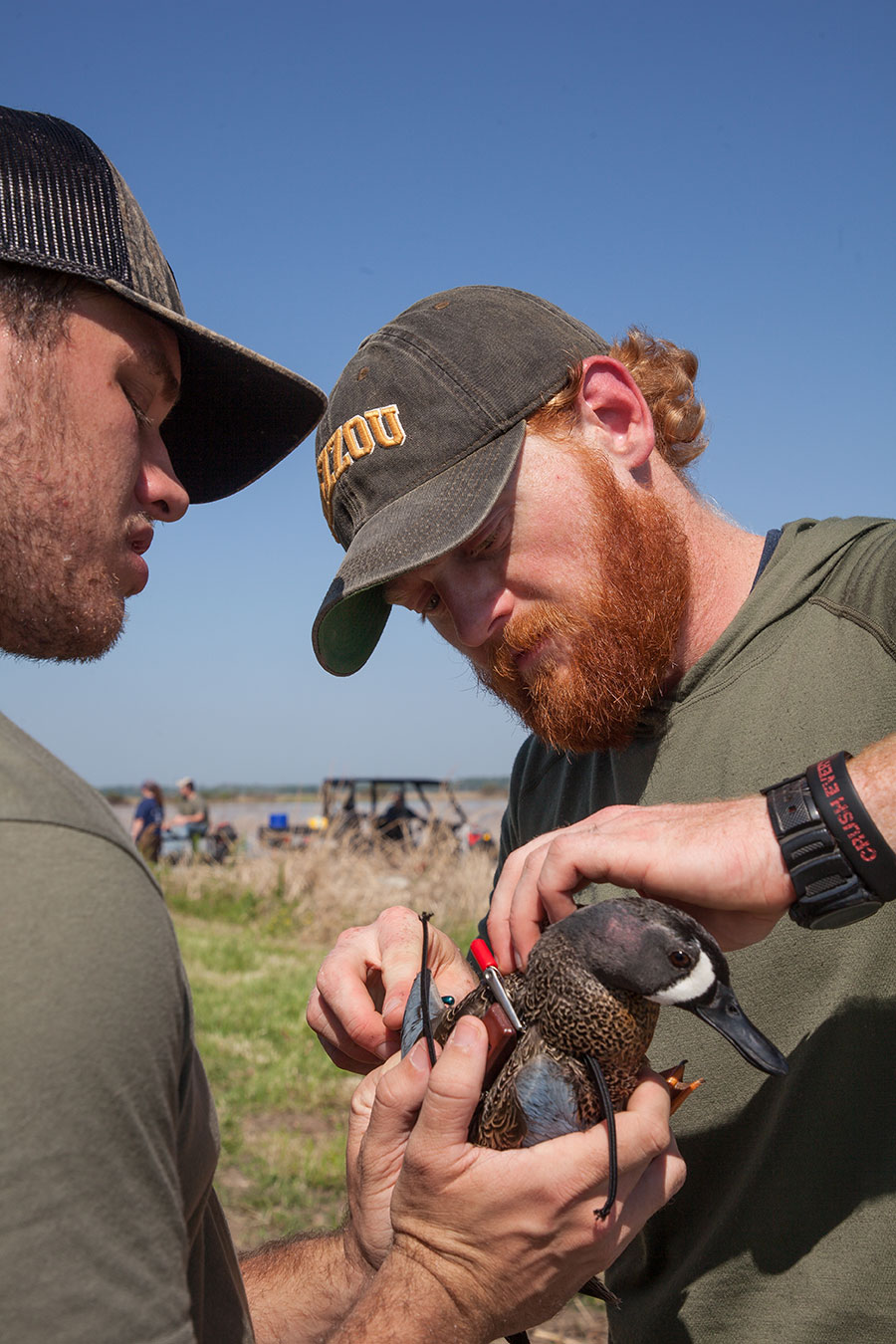
Deb Carter suddenly raised her hands and in a firm voice said, “Everybody STOP!”
Just moments earlier, Paul Link, a Louisiana Department of Wildlife and Fisheries Biologist Supervisor on Rockefeller Refuge, had fired a rocket net capturing nearly 400 blue-winged teal. Now the somewhat stressed teal were in crates waiting to be processed by Carter’s team.
In that instant, raising tensions were some 20 eager Stephen F. Austin University student volunteers who were spilling excited energy all over the levee that divided the crawfish ponds where the birds would be handled.
This capture took place during the spring of 2023 and was part of a continuing program that has been conducted during March and April for the past 12 years by the University of Georgia Southeastern Cooperative Wildlife Disease Study and the Louisiana Department of Wildlife and Fisheries. The program monitors low and high pathogenic avian influenza diseases, also known as bird flu. The knowledge gained helps protect teal as well as other types of ducks and waterfowl.
Short trip
This past winter, I happened to share a duck blind with Bill Lake, owner/operator of Bayou Guide Service, where he told me about a blue-winged teal he shot the previous weekend.
When I asked, “Oh yeah. Where was it banded?” thinking somewhere up north in Canada.

Lake replied, “Krotz Springs.”
I told Lake that I had probably witnessed his bird get banded. Essentially that particular blue-winged teal in all likelihood arrived at the Krotz Springs capture site during its northerly migration from Central or South America last spring, then migrated to the breeding grounds in the upper U.S. or Canada shortly after. And finally, it was harvested by Lake during its southerly migration during the fall.
In short, it shows the intercontinental travel of this particular species of ducks. Hence, the importance of it being the subject for avian influenza studies.
This past year on Dec. 12, the LDWF issued a press release noting that avian influenza had once again caused mortalities in wild birds in Louisiana, noting that the disease had started the previous year. What’s more, it only abated when they moved north during the spring of 2023.
Carter’s “Stop” command and moment of seriousness got everyone’s attention and quickly refocused the group on the real reason they were there. Like a drill sergeant, she quickly gave out assignments and instructions where the SFA collegiate volunteers became a well-oiled machine in safely and efficiently processing the teal.
Carter, a research professional who works in the Department of Pathology in the College of Veterinary Medicine at UGA, at the time said high pathogenic influenza had affected nearly 100 different avian species and some mammals over the previous year.
A big concern
Carter said, “It’s a big concern for us. Obviously, it hits the poultry farms because the wild birds are bringing it over here during their migrations. So, teal happen to be the host for some of it. They don’t always show clinical signs, but they are carriers so we’re studying them closely.

“We’ve actually been studying them for years,” Carter continued. “We’ve found low pathogenic avian subtypes in them and this past year we found the high pathogenic.”
The field capture work includes taking teal from their holding crates to a banding station, where they are banded and recorded as part of the Bird Banding Laboratory/U.S. Geological Survey scientific program. Not only does it take a large group of volunteers to clear a net of captive waterfowl, but also the systematic handling of the birds station to station before they are released; hopefully with no mortality.
After banding, a percentage of the teal are taken to a station where they go through the indignities of throat and posterior swab sampling, by trained field technicians like Carter, before going to a final station where blood samples are taken.
Swab samples let biologists know if the teal are currently carrying pathogens, where blood samples will let them know if the birds have antibodies.
During much of 2022 and 2023, inflation and high fuel prices caused an increase in egg prices for consumers. On top of that came avian influenza. One 2023 report, from Texas A&M, indicated that close to 50 million chickens in 46 states had perished due to the outbreak of avian influenza.
Allison Vestal-Laborde is a Ph.D. student in the School of Renewable Natural Resources at Louisiana State University and also works full time at the LSU School of Veterinary Medicine.

While Carter was working one end of the swabbing and bloodletting table, Laborde was working a station on the opposite end. Laborde’s interest in teal was to look for avian corona viruses.
“Avian corona viruses are not quite as typical as influenza right now, but as with the human side, we have a real interest in corona viruses in wildlife,” Laborde said. “We know that birds have corona virus, because it is very common in domestic poultry, but we don’t know as much about waterfowl. There have been a few studies that have shown 10 percent of birds are carrying avian corona viruses and we’re not quite sure what that’s doing to them.”
Critical information
Laborde said part of her work is to see if waterfowl have avian corona virus when they are migrating in and out. Moreover, how does avian corona virus affect their reproduction, because it does affect domestic poultry reproduction.
“The information could be crucially important for wildlife that are of a population like some of our cavity nesting birds,” Laborde said.
During the 2023 spring banding period, Jeff Edwards, a University of Missouri graduate student working on his master’s degree, attached GPS transmitters to 9 of the healthiest blue-winged teal specimens captured that morning.
The solar powered GPS transmitters track each bird’s location every 4 hours as long as they are in 4G cell phone coverage. Every 12 hours, all of the locations are then transmitted to a data base that can be accessed and monitored.

In what he’s attempting to learn, Edwards said, “We’re looking to track how wetland inundation trends are effecting their habitat selection and survival throughout the non-breeding season. So, we’re kind of looking at the spring migration as to how water on the landscape is effecting how far they might make a migratory jump and if that is affecting survival during the spring season and maybe into the breeding season. So, we’re taking a look at these cross-seasonal effects by tracking them.”
The GPS transmitters are fixed to an elastic harness strapped onto the ducks body and typically weigh 10 grams. Each GPS transmitter can only equal and not exceed 3 percent of the bird’s weight. Most of the teal selected by Edwards weighed over 400 grams or just over 14 ounces.
“The first thing we do before we get going is to make sure they make weight,” Edwards said. “We want the healthiest birds we can get. So, we try to keep the birds above 400 grams.”
Female blue-winged teal are usually fitted with GPS transmitters, but Edwards also included several males. According to Edwards, it’s not common for people to study males.
“People seem to think blue-wing males exhibit different migration strategies and to my knowledge, nobody in the world has put transmitters on male blue-winged teal, which is crazy,” Edwards said. “So, it will be cool for us to look at that and differentiate survival where fall migration and resource selection is concerned.”
Globally, the concern of various diseases spreading remains at the forefront of people’s mind in a post COVID world. Monitoring diseases carried by wildlife, particularly waterfowl, acts as an early warning signal, where agriculture agencies can develop strategies to mitigate outcomes.
The LDWF and UGA are continuing banding studies this spring.